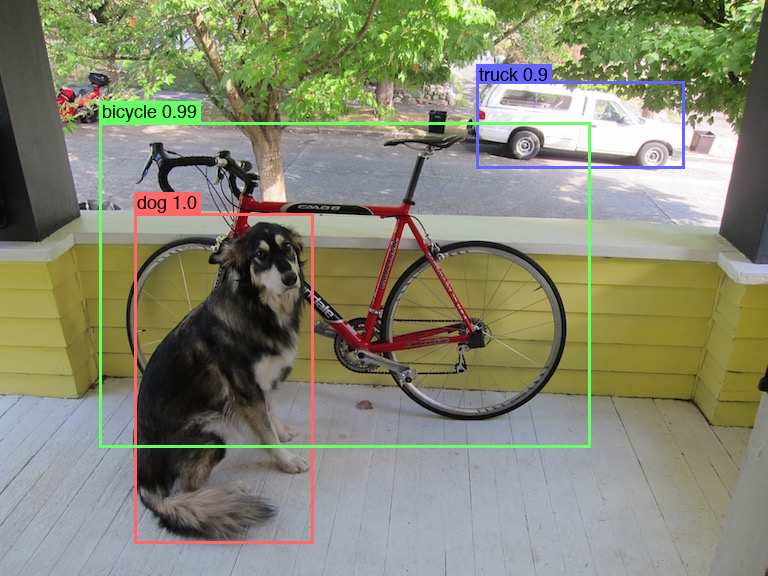D2K implements the YOLOv4 and YOLOv3 object detection algorithms in Keras/TensorFlow 2.1.0. Most everything was implemented test-first and the results match the original Darknet and YOLOv4's Darknet (allowing for floating point error fun).
D2K is inference-only so far... (Re-)training is where things really get fun, though, so I'll be looking into adding it as time allows.
The YOLOv3/YOLOv4 weights files are too big for checking into GitHub directly, but if you have Git LFS set up, cloning the repository should get you copies. Otherwise, after cloning you'll need to get it from the Darknet site:
wget https://pjreddie.com/media/files/yolov3.weights
mv yolov3.weights darknet-files/See the YOLOv4 GitHub page for where to download the yolov4 weights.
You shouldn't have to install anything. On an Python 3, Tensorflow 2 environment try:
python yolo.py tests/data/dog.pngIn Python, using it is as simple as, for example,
net = d2k.network.load(Path('darknet-files/yolov3.cfg').read_text())
net.read_darknet_weights(Path('darknet-files/yolov3.weights').read_bytes())
model = net.make_model()
image = d2k.image.load(image_file)
boxes = d2k.network.detect_image(model, image)
im = Image.open(image_file)
d2k.box.draw_boxes(im, boxes)
im.show()For the tests, you'll need Darknet built on ../darknet, as I embed it using
ctypes. I suggest you use
my clone of Darknet given a couple
of small bugs I fixed (found while coding this project) and also an adjustment
to gcc options.
There is an equivalent branch for YOLOv4.
pushd ..
git clone https://github.com/jaltmayerpizzorno/darknet.git
cd darknet
makeThen return to D2K and simply make test:
popd
make testTo see the Keras/Tensorflow NN used, you can pass --print to yolo.py:
python yolo.py --version 4 --print
layer_in = keras.Input(shape=(608, 608, 3))
layer_0 = keras.layers.ZeroPadding2D(((1,1),(1,1)))(layer_in)
layer_0 = keras.layers.Conv2D(32, 3, strides=1, use_bias=False, name='conv_0')(layer_0)
layer_0 = keras.layers.BatchNormalization(epsilon=.00001, name='bn_0')(layer_0)
layer_0 = layer_0 * K.tanh(K.softplus(layer_0))
layer_1 = keras.layers.ZeroPadding2D(((1,1),(1,1)))(layer_0)
layer_1 = keras.layers.Conv2D(64, 3, strides=2, use_bias=False, name='conv_1')(layer_1)
...
The d2k.network.Network class reads a Darknet configuration file and generates an equivalent
Keras model; its convert() outputs a list of Python statements building the model, making it
easy to check (and incorporate elsewhere if desired). It can also read Darknet YOLOv3/YOLOv4
weights into the resulting model, for use and/or for serializing for later use.
The files under darknet-files are all originally from the Darknet authors,
included here for convenience.
- add training support
- move non-max suppression into the neural network
- look to support additional layers
There are YOLOs aplenty. Here are some I find particularly noteworthy:

